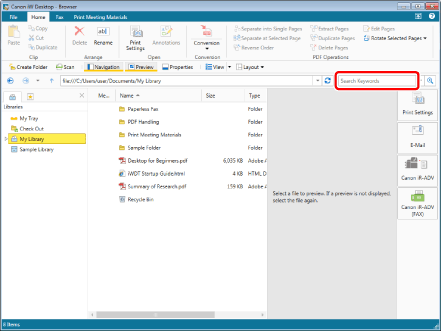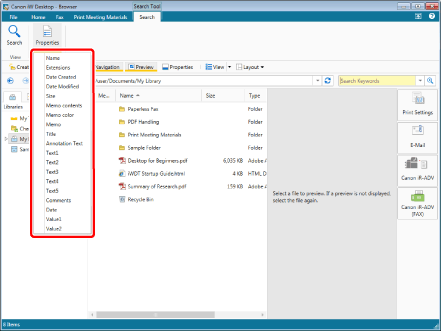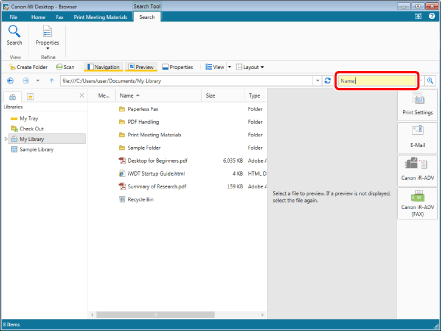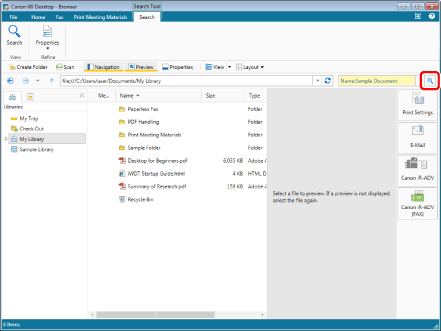Searching from the Simple Search Bar
You can enter a search keyword in the simple search bar to perform a full-text search or folder/document properties information search.
|
NOTE
|
|
Even if you use the same search keyword, the search results vary depending on the libraries and folders specified as the search target. For more information, see the following.
Library Search Results (Administrator Guide)
To perform a full text search in Desktop, preparation is required.
For information on how to perform full text searches in a Personal Library, refer to the "Installation Guide"
For information on how to perform full text searches of documents/folders in a Network Library that is not managed in a database, see the following
Installing Desktop Index Filter (Administrator Guide)
If you change the display format for dates or numeric values in [Control Panel] > [Clock, Language, and Region] > [Region and language], you need to rebuild indexes to perform searches using the new display format. For more information on how to rebuild indexes ([Control Panel] > [Indexing Options] > [Advanced] > [Rebuild]), refer to the Help for your computer.
For more information on document/folder properties, see the following.
When searching for documents on the simple search bar using property information, you can perform a detailed search by searching in the 'property name:search keyword' format. You can search more quickly by specifying the properties of the search targets. (You can enter either a double-byte or single-byte colon.)
Example) 'Name:Sample Document'
Annotation text created with Desktop V2.0.1 or earlier is not searched. Use Annotation Convert Tool to convert the annotations to PDF format annotations.
|
1.
In the Navigation Window, select a library or folder to search for folders and documents.
|
NOTE
|
|
You cannot search for documents in the Recycle Bin, check out folder, or My Tray.
|
2.
Click the entry field on the simple search bar.
If you are performing a simple search, proceed to step 4.
If you are performing a detailed search, proceed to step 3.

The [Search] tab is displayed on the ribbon.
|
NOTE
|
|
Clicking
A maximum of 10 search keywords
A maximum of three property names of search targets
|
3.
Click  (Properties) on the ribbon, and select the property name to search for.
(Properties) on the ribbon, and select the property name to search for.
 (Properties) on the ribbon, and select the property name to search for.
(Properties) on the ribbon, and select the property name to search for.
The selected property name is displayed on the simple search bar.
|
NOTE
|
|
Clicking
 (Properties) on the ribbon displays the types of properties that can be searched for in the selected library. (Properties) on the ribbon displays the types of properties that can be searched for in the selected library.For details on the properties, see the following.
|
4.
Enter a search keyword in the simple search bar.
Or, follow one of the steps described below.
To perform a simple search, click  on the simple search bar and select a search keyword from the list of saved keywords.
on the simple search bar and select a search keyword from the list of saved keywords.
To perform a detailed search, click  on the simple search bar and select a saved property name of the search target history (in blue).
on the simple search bar and select a saved property name of the search target history (in blue).

|
NOTE
|
|
Enter the search keyword after the 'property name:' in blue.
Enter property keywords that are not in the text format as indicated below.
Memo:Yes (When searching for a document with a memo attached)
Memo color:Gray/Orange/Blue/Red/Yellow/Green/Cyan/Magenta (When searching with a memo color)
You can enter single or double-byte spaces as keyword separators. When a search is executed, search results that include all the separated strings are displayed.
In a document inside a Document Server Library, when using a word which does not make sense as a search keyword (e.g., "a" or "the"), all documents within the search range, including those which do not contain the search keywords, will be displayed.
|
5.
Click  (Start Search) on the simple search bar.
(Start Search) on the simple search bar.
Or, click  (Search) on the ribbon.
(Search) on the ribbon.
 (Search) on the ribbon.
(Search) on the ribbon.
The search results are displayed on the Search Screen.
To pause searching, click [Cancel Search] on the Search Screen.
|
NOTE
|
|
This operation can also be performed with the tool buttons on the toolbar. If tool buttons are not displayed on the toolbar of Desktop Browser, see the following to display them.
The search results view switches between [Large Thumbnail], [Medium Thumbnail], [Small Thumbnail], and [List] each time you click
You can preview the documents found in the search on the Search Screen. For more information, see the following.
To display the Search Screen always in front of the Desktop Browser screen, click
The path of the search target library or folder is displayed in [Search Location] on the Search Screen.
In the case of an IWB document to which text decoration has been applied, editing or searching text decoration may not be performed depending on characters of text decoration.
If you selected a Network Library (database) to search, the following information is displayed on the bottom of the Search Screen.
[Database Modified Date]:
Displays the date and time that the database was last updated with a periodic update. If a long time has elapsed since the displayed date and time, the content of the database may be old. When searching property information ([Name] and [Extensions]), you can select the [Do not use the indexes created for search when searching (might be slow)] check box to search the latest information.
[Number of PDF Documents Whose Index Have Not Been Retrieved]:
Displays the number of documents without annotation text and property information ([Pages] and [Inserted Annotations]) saved in the database. If annotation text cannot be properly searched or the property information is not correctly displayed in the search results, perform the search again after waiting a while so that the number of documents is reduced.
In any of the following cases, the Search Screen is displayed without executing a search.
When a library or folder is not selected in the Navigation Window
When a location that cannot be searched is selected in the Navigation Window
When a search keyword has not been entered
If there are no search results found that match the search conditions when performing a search in the 'property name:search keyword' format, change the search conditions in the displayed detailed Search Screen and perform a detailed search again. For more information on detailed searches, see the following.
|